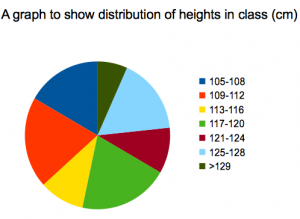Visualising data
Idea for a teaching strategy based on a class of 30
Lesson idea. Students measure themselves (including but not limited to; arm length, height, hand span) and then analyse their data to look for patters of distribution amongst the class. A spreadsheet allows graphs showing the data to be drawn instantaneously as the data is input - helping students to visualise the variation and distribution of the data within the class.
Teaching approach. The lesson offers the opportunity to explore measurement, relationships between measurement, and ways to visualise and summarise this data. The use of ICT(i) allows the teacher to enter data and for pupils to immediately see the impact this has on the pie chart and frequency tables (which are automatically updated). This also allows the teacher to change the 'range' for the frequency counts, and discuss with pupils the impact of this on the pie chart, and whether this is a good representation - encouraging the use of mathematical language(ta) and scientific method(ta) throughout. In collecting the data pupils have opportunity for some self-directed group work(ta) - to measure various lengths as described below - and the teacher could use whole class(ta) questions(ta) to explore the strategies taken to conduct this investigation(ta). (edit)
| Resource details | |
| Title | Variation of human characteristics - Visualising Class data |
| Topic | [[Topics/Graph|Graph]] |
| Teaching approach | [[Teaching Approaches/Investigation|Investigation]], [[Teaching Approaches/Questioning|Questioning]], [[Teaching Approaches/Whole class|Whole class]], [[Teaching Approaches/Language|Language]], [[Teaching Approaches/Group work|Group work]], [[Teaching Approaches/Scientific method|Scientific method]] |
| Learning Objectives |
|
| Subject | [[Resources/Science|Science]] |
| Age of students / grade | [[Resources/Primary|Primary]], [[Resources/KS1|KS1]] |
| Additional Resources/material needed |
|
| Useful information | National Curriculum reference: KS1, Sc1 2h, KS1, Sc2 4a.
|
| Files and resources to view and download |
Both files will automatically update the pie chart for data. You can add as many children as you like, and you can change the ranges given in the tables (but you cannot add or remove rows - the number of intervals should stay the same). Change the data being visualised by using the 'drop down' menu on the excel sheet.
|
3 'measuring' work stations set up (one for each continuous variable: height, hand span and arm length) with space and materials for 3 groups of 3-4 around each station. Each pupil to be given a personal data slip that they must complete whilst working in groups of 3-4.
Data slip could be something simple like this:
Name:________________________ Height (cm):__________________ Hand span (cm):______________ Arm length (cm):_____________
Collect data (pupils could enter the data directly into a class spread sheet projected on to a white board) as each set of three groups finishes at their station making sure each pupil has their personal data completed on their data slip before moving to the next station. Groups circulate through all three stations helping each other to make accurate measurements.
Data could be collected in one lesson and analysed in a further lesson. This gives the teacher time to set up the range fields on the spreadsheet based on the data collected.
Possible Extension Activities
- Data sets for other classes (or indeed the whole school) could be collected and students could see if the patterns/distributions seen in one class were similar/different to others.
- Calculators could be used to work out averages and other data analysis as an alternative, see moving stones activity for examples
- Some students may analyse the data further, calculating the mean, mode, median of the data set (see counting stones activity for more suggestions and instructions)
Extension/enrichment activities: Hand span measurement could be used to measure arm length/hand (see professional development PDF below) could be drawn around on square paper and the area worked out and compared with HS to look for patterns/data could be analysed by sex, age, to look for patterns also pattern spotting between variables.
- the Witch's Hat is a fun drama lesson plan to introduce measuring in cm. (av. rating 4.7/5 out of 12 ratings on TES) http://www.tes.co.uk/teaching-resource/MATHS-DRAMA-LESSON-THE-WITCH-S-HAT-6013315/review/1/
- photo and info for measuring hand span: http://www.topendsports.com/testing/tests/hand-span.htm
- great professional development PDF explaining in detail a lesson on using hand spans to measure arm length: http://www.mathsolutions.com/documents/0-941355-42-X_L2.pdf


